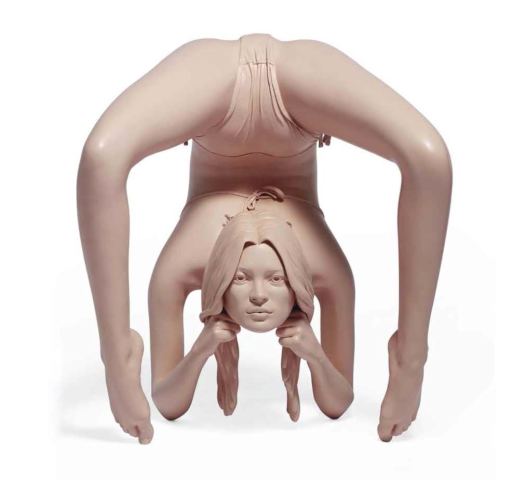Sphinx (Fortuna) Pink , 2006
Painted bronze
75,4 x 64 x 67 cm
1 + 1
Copyright The Artist
Signifying the idea that human being is a miniature representation of the universe, 'Sphinx Pink' is one of many scultpures by Quinn that depict English model Kate Moss in yoga-like...
Signifying the idea that human being is a miniature representation of the universe, "Sphinx Pink" is one of many scultpures by Quinn that depict English model Kate Moss in yoga-like poses.
These sculptures, both materially and ideally, at times bare strong resemblance to statues of the Indian deity Shiva, and sometimes to statues of Roman goddesses Fortuna and Venus, and other times to all three at once. Quinn's choice of Kate Moss's image is no accident. Citing the fact that Moss rarely gives public talks, Quinn says that she was the inspiration for this series of sculptures because she seemed like a "frozen flower" to him.
"Sphinx Pink" is obviously inspired by both Fortuna and Venus. Just like "Microcosmos" its body displays references to the goddess Fortuna (see "Microcosmos, Fortuna, 2008). With respect to the name "Sphinx Pink" however, the sculpture hearkens back to the rebirth of Venus. With its colour - pink which is associated with feminity, charm, romance, sensivity, tenderness and politeness - it also transmits the powers that reside within Venus. When looked at through this intertextual awareness Quinn's "Sphinx Pink" how Venus and Fortuna merge into oneanother and are transformed into the pink wheel of fortune. Thus the circular act of moving in the universe that offers both the good and the bad is celebrated. By way of this merging and transformation we see how the visual arts maybe used to praise the circular nature of the movement of the universe. This movement perhaps offers love and romance through this image of Kate Moss.
As a response to the goddesses Fortuna and Venus through another kind of beauty, "Sphinx Pink" competently complies with the philosophies the deities spread. Embraced as an act of recreating, "Sphinx Pink" demonstrates how, in our age, art and belief are openly interconnected in the works of artists like Quinn who have universal concerns. And the question all of these artists ask in their capacity as mirror images of the hands of "The Creator" is: Who are we?
© Cigdem Mirol
These sculptures, both materially and ideally, at times bare strong resemblance to statues of the Indian deity Shiva, and sometimes to statues of Roman goddesses Fortuna and Venus, and other times to all three at once. Quinn's choice of Kate Moss's image is no accident. Citing the fact that Moss rarely gives public talks, Quinn says that she was the inspiration for this series of sculptures because she seemed like a "frozen flower" to him.
"Sphinx Pink" is obviously inspired by both Fortuna and Venus. Just like "Microcosmos" its body displays references to the goddess Fortuna (see "Microcosmos, Fortuna, 2008). With respect to the name "Sphinx Pink" however, the sculpture hearkens back to the rebirth of Venus. With its colour - pink which is associated with feminity, charm, romance, sensivity, tenderness and politeness - it also transmits the powers that reside within Venus. When looked at through this intertextual awareness Quinn's "Sphinx Pink" how Venus and Fortuna merge into oneanother and are transformed into the pink wheel of fortune. Thus the circular act of moving in the universe that offers both the good and the bad is celebrated. By way of this merging and transformation we see how the visual arts maybe used to praise the circular nature of the movement of the universe. This movement perhaps offers love and romance through this image of Kate Moss.
As a response to the goddesses Fortuna and Venus through another kind of beauty, "Sphinx Pink" competently complies with the philosophies the deities spread. Embraced as an act of recreating, "Sphinx Pink" demonstrates how, in our age, art and belief are openly interconnected in the works of artists like Quinn who have universal concerns. And the question all of these artists ask in their capacity as mirror images of the hands of "The Creator" is: Who are we?
© Cigdem Mirol
